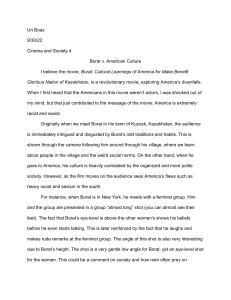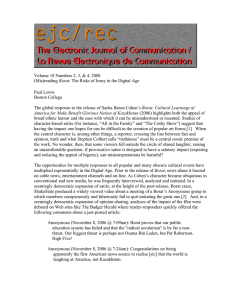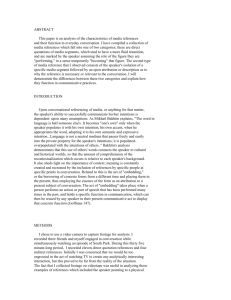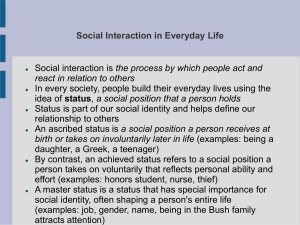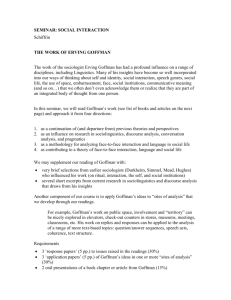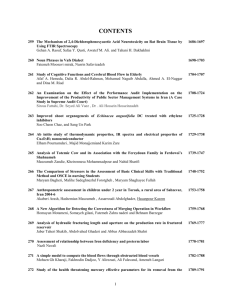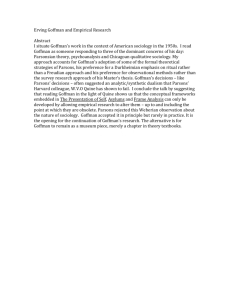Emily Final
advertisement
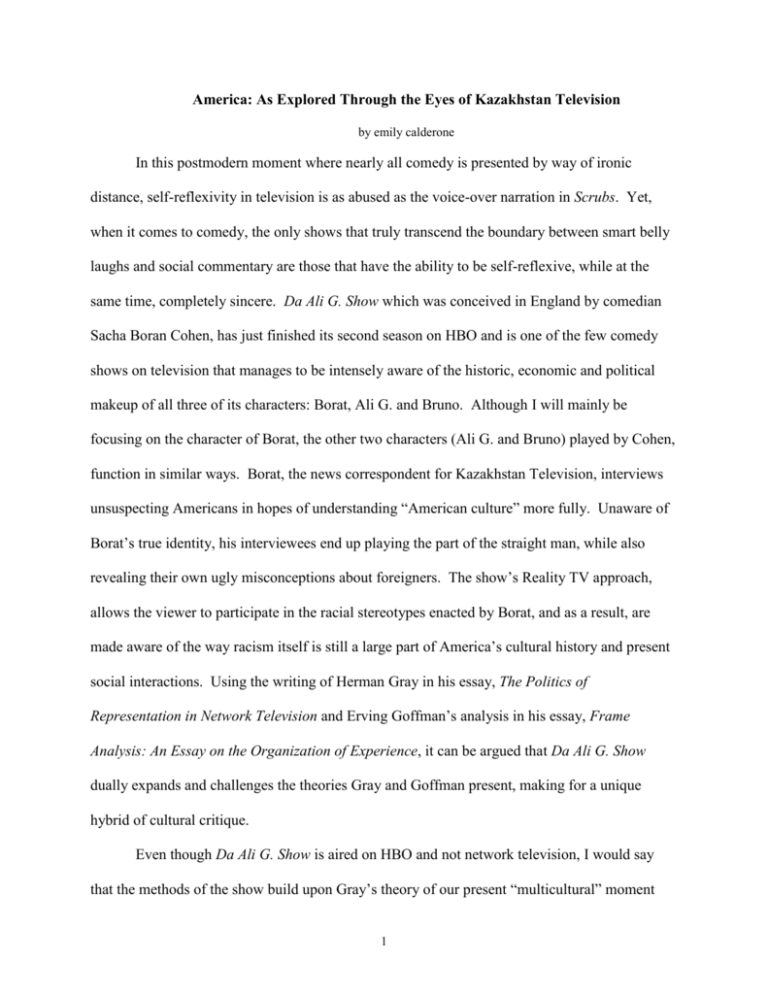
America: As Explored Through the Eyes of Kazakhstan Television by emily calderone In this postmodern moment where nearly all comedy is presented by way of ironic distance, self-reflexivity in television is as abused as the voice-over narration in Scrubs. Yet, when it comes to comedy, the only shows that truly transcend the boundary between smart belly laughs and social commentary are those that have the ability to be self-reflexive, while at the same time, completely sincere. Da Ali G. Show which was conceived in England by comedian Sacha Boran Cohen, has just finished its second season on HBO and is one of the few comedy shows on television that manages to be intensely aware of the historic, economic and political makeup of all three of its characters: Borat, Ali G. and Bruno. Although I will mainly be focusing on the character of Borat, the other two characters (Ali G. and Bruno) played by Cohen, function in similar ways. Borat, the news correspondent for Kazakhstan Television, interviews unsuspecting Americans in hopes of understanding “American culture” more fully. Unaware of Borat’s true identity, his interviewees end up playing the part of the straight man, while also revealing their own ugly misconceptions about foreigners. The show’s Reality TV approach, allows the viewer to participate in the racial stereotypes enacted by Borat, and as a result, are made aware of the way racism itself is still a large part of America’s cultural history and present social interactions. Using the writing of Herman Gray in his essay, The Politics of Representation in Network Television and Erving Goffman’s analysis in his essay, Frame Analysis: An Essay on the Organization of Experience, it can be argued that Da Ali G. Show dually expands and challenges the theories Gray and Goffman present, making for a unique hybrid of cultural critique. Even though Da Ali G. Show is aired on HBO and not network television, I would say that the methods of the show build upon Gray’s theory of our present “multicultural” moment 1 (299). Throughout his essay, Gray outlines three different discourses surrounding Black representation in television (although they can broadly apply to any race representation). They are: “assimilationist discourse” which believes racism must be overcome by color-blindness, a “pluralist discourse” which believes people live in their separate but equal worlds, and “multicultural discourse” which takes history, economy and political activism into account (285). The historical moment we inhabit today embraces a multicultural discourse, although Gray believes all three discourses can exist at one time. In many ways Da Ali G. Show relays a multicultural discourse because it “create[s] a discursive space in which subject positions are transgressive and contradictory, troubling and pleasurable, as are representations used to construct identity” (299). This can be demonstrated in a very telling sequence at Colonial Williamsburg where Borat obsessively asks the town blacksmith, shoemaker and dressmaker if they are slaves and if he can buy them. It makes for a hilarious scenario to the viewer, not only because Borat cannot let this question go, but mostly because there is pleasure involved in watching people devoted to upholding the purity of American history, deny the slavery that built America into such a powerful nation. Although Borat may seem hopelessly naïve to the people he questions, it becomes clear to the viewer that he knows exactly which buttons to push in order to reveal facts that repeatedly get swept beneath the carpet in American history. Even though Borat enacts and upholds Gray’s “multicultural” discourse, he also challenges it at the same time by presenting his unsuspecting interviewees with an incredibly stereotypical character. Dressed in an ill-fitting grey suit, sporting a thick black mustache, Borat searches for a deeper understanding of U.S. culture. In one episode, Borat visits a gun club in Texas. During the interview, he asks the leader of the gun club, if American gun clubs can execute killers like they do in Kazakhstan. The interviewee 2 laughs and says, no; the execution of killers is left to the government. In his stereotyped naiveté, Borat compares the hotly debated topic of capital punishment to Barbarism. This deeper questioning of American values takes the laughter away from Borat’s racial otherness and places it on the people who accept Borat’s stereotyped character. It is this complex relationship between the viewer, the actor and the unsuspecting people he interviews that is particularly unique about Da Ali G. Show. Traveling around America (mostly in the Southern states) Borat’s various segments consist of learning Southern etiquette, taking trips to Colonial Williamsburg, and learning how to speed date. Everything from his very personal greetings, to his outlandish statements about his dead wife back in Kazakhstan, allow the audience in on the joke that he is playing into the stereotype many Americans have of foreigners. In his book, Frame Analysis Erving Goffman defines a “frame” as the viewer’s perception of the reality experienced at one moment in time (379). When “ the nature of engrossment and belief suddenly changes,” the viewer has what Goffman describes as a “negative experience” (378). For instance, the interviewee’s frame of mind is that Borat is a real person from Kazakhstan who seeks enlightenment on the American way of life. As a result, anything he does that is out of the ordinary becomes not the attitude of a well-skilled comedian, but that of a foreigner who is clueless of American customs. The viewer on the other hand, knows that Borat is a fictional character played by Cohen. Therefore, they are equipped with knowledge of Cohen’s performance and as a result, become participants in that performance. In some cases, that very aspect of participation could incite a stronger awareness of race relations on the part of the viewer. If Goffman were to analyze Da Ali G. Show he might say that Cohen is the person in charge of the interviewee and the home-viewer’s negative experience. Goffman also identifies 3 that one of the ways in which the performer has the ability to disorient or create a negative perception of reality on the part of the interviewee is to make apparent what is often referred to as the “disattend track” (422). Goffman defines this term as the exchanges that take place in most human interactions that are commonly glossed over and not commented on, like issues regarding race or gender. For instance, whenever Borat greets someone, he leans over in a strange handshake-hug-kiss. The person interacting with him is visibly uncomfortable but never comments on the awkward exchange. The incredibly revolutionary aspect of Borat’s character is that almost every one of his comments are about things that people usually ignore in conversation. In one very telling episode, Borat sits with a group of white Southerners at a wine tasting. When one of the servers (who happens to be Black) gives Borat more wine, he leans over to his host and asks, very quietly, “is he a slave?” His host laughs and tells Borat that slavery has been abolished for quite some time. This question serves many different purposes because not only does it comment on the history of the South, but it also comments on the many ways in which the South still upholds a social and economic hierarchy that continues to place Black people in subordinate roles in society. Goffman theorizes that if the actor “chooses to deviate from the norms, his action will hardly be disattendable” (422). This is the way in which Cohen, as the actor playing Borat, constantly brings out issues that wish to be ignored or “disattended” to. He makes apparent the underlying prejudices and racism still wedged in the cracks of the Old South and throughout the rest of the country, which is revealed in other segments. What truly sets Da Ali G. Show apart from other Reality TV comedy shows is its ability to transcend the laughs associated with ridiculous racial types and use those types to reveal even uglier ideologies surrounding racial otherness in America. In a sense, the low-quality video used 4 in Borat’s segments is just as muddied as America’s conceptions of people from other countries. What takes place is a pretty harsh critique of American culture that is formed by a character who is not only a stereotype, but a seemingly inarticulate stereotype at that. Borat greets his interviewees with the sincerity of a freshman college student meeting his teaching assistant for the first time. He is willing to learn and obey the rules of the classroom and always has a question for the class. It is this sincerity that allows Borat to claim his stereotyped character and use it to reflect all of the ways in which other people perceive him. Commonly dismissed as nothing more than lowbrow humor, there is more to Da Ali G. Show than a man dressed in a cheap suit, sporting a thick black mustache. Sources: 1. Goffman, Erving. The Manufacture of Negative Experience. Frame Analysis. Boston: Northeastern UP. 1974. 378-379. 2. Gray, Herman. The Politics of Representation in Network Television. Watching Race: Television and the Struggle for Blackness. Minneapolis: University of Minnesota Press. 1995. 285-299. Drop Quotes: Commonly dismissed as nothing more than lowbrow humor, there is more to Da Ali G. Show than a man dressed in a cheap suit, sporting a thick black mustache. Traveling around America (mostly in the Southern States) Borat’s various segments consist of learning Southern etiquette, taking trips to Colonial Williamsburg and learning how to speed date. This deeper questioning of American values takes the laughter away from Borat’s racial otherness and places it on the people who accept Borat’s stereotyped character. Word count: 1462 (without title, quotes, or sources) 5 6
